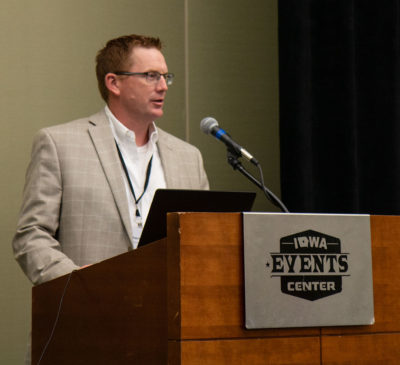 Wall presents updates of the UGC moving forward.
Wall presents updates of the UGC moving forward.
“During the certification process, technicians scanned big, heavy, fat steers for the most part. It is a difficult set of cattle so we’re running those people through the gauntlet and really testing whether they know how to collect a quality image or not. It’s not just a formality that you go through this test, it is a test that is difficult to pass,” explains Ultrasound Guidelines Council (UGC) Executive Director Patrick Wall. Wall gave a UGC update during the Beef Improvement Federation (BIF) Symposium June 24, 2021, in Des Moines, Iowa.
2020–21 UGC highlights
During 2020-21, UGC performed annual Lab Technician Certifications for approximately 30 technicians and collected carcass data and ether extract i.e. intramuscular Ffat (IMF) analysis on 133 head. The council re-instated In Absentia Field Certification for 2021, which will result in every active machine having carcass data behind it every four years. Some UGC technicians had not had carcass data behind their equipment in 15 years and many had purchased new machines with no carcass data comparisons. This resulted in new field certification requirements for all UGC technicians.
“We got rid of the repeatability column,” Wall said. “After a long look at the stats in field certification, no one ever really failed based on repeatability. Either you knew what you were doing the first time the animal came in the chute or you didn’t. We were thirsty for carcass data so rather than doing 20 head and repeating that we went to 40 head at once. This allowed us to get more carcass records, allowed the technicians to scan a wider variety of cattle, and it gave us the opportunity to go get more variation.”
Areas of concern
The UGC has some concerns with established technology performing poorly against carcass data and not all machine problems being visible to the naked eye. UGC can only test one machine-technician combination at a time. This becomes a significant issue as some technicians have multiple machines. The UGC is looking to address this concern while making the best economical decision. Packing plant access is an ongoing challenge. Sites for carcass data (and IMF slivers) are quite limited.
“Packing plant access got really difficult during COVID, almost impossible and we relied on internal packing plant employees to get ether extract data and carcass data back out,” Wall explained. “They flat missed a tag transfer and there was nothing we could do. So that was really frustrating, and I don’t think that problem’s going away,”
Next steps
New technicians must participate in UGC Field Certification in-person every two years to check machine performance. Technicians that meet the standards for In Absentia Certification must re-test in-person every four years. If they change technologies, the technicians will have to repeat the certification process at the next available event. As a result, UGC will get carcass data on every machine used actively in the industry every four years. All 125-plus technicians nationwide will have carcass data behind their machine so issues can be detected and corrected before the integrity of the data is compromised. UGC is offering intramuscular fat (IMF) data from the Field Certifications to help labs improve models across a wide variety of machines. UGC will expand work with Bos indicus breeds to test the robustness of %IMF models.
“UGC has budgeted some travel dollars for me to inform breed association board of directors on how the current performance of the technology is doing. Where are we good? Where do we need to fix? What do we need to do decision-wise to make moving forward? Should we be doing anything differently? Those folks are the decision makers. We are the guidelines. They decide what they want to do with ultrasound data in their own particular breed,” Wall added.
To watch the full presentation, visit https://youtu.be/flX_bfJzExw. For more information about the Symposium and the Beef Improvement Federation, including additional presentations and award winners, visit BIFSymposium.com.
